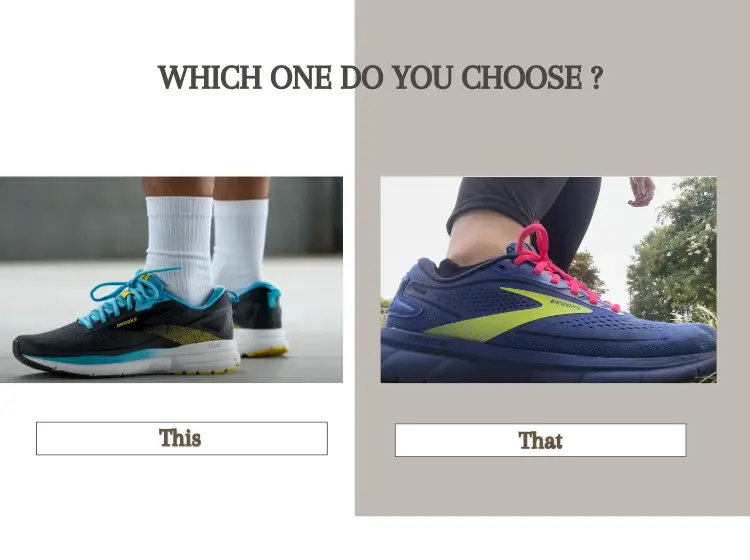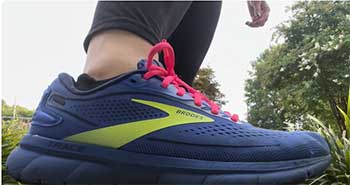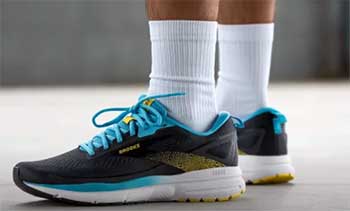As a runner who’s pounded the pavement in countless shoes, I’m always curious about how a brand evolves its lineup. Today, I’m putting the Brooks Trace 2 and Trace 3 under the microscope to compare their performance, comfort, and value. My goal is to help you decide which shoe fits your running style, whether you’re a beginner or a seasoned heel striker.
Through my firsthand experience and detailed analysis, I’ll break down the pros, cons, and key differences to guide your next purchase. Let’s lace up and get started!

A Brief Comparison Table
| Feature | Brooks Trace 2 | Brooks Trace 3 |
| Price | $100 | $100 |
| Weight (Men’s US 9) | 8.6 oz (244g) | 9.1 oz (257g) |
| Weight (Women’s US 8) | 7.6 oz (215g) | 7.2 oz (204g) |
| Heel-to-Toe Drop | 12 mm | 11.9 mm |
| Midsole Foam | BioMoGo DNA | DNA Loft |
| Stack Height (Heel) | 24 mm | 34.1 mm |
| Stack Height (Forefoot) | 12 mm | 22.2 mm |
| Toebox Width | 96.3 mm (snug, average) | 97.4 mm (more spacious) |
| Upper Material | Engineered mesh, 45.3% recycled | Engineered air mesh |
| Outsole | Rubber with segmented crash pad | Rubber with enhanced flexibility |
| Fit | True to size, snug toebox | True to size, roomier toebox |
| Best For | Heel/midfoot strikers, daily training | Heel strikers, beginners, daily use |
My Journey with Brooks Trace 2 and Trace 3
I’ve been running for over a decade, and Brooks has always been a go-to brand for me. Their shoes strike a balance between affordability and reliability, which is why I was excited to test both the Trace 2 and Trace 3. I wore each pair for about 100 miles, mixing road runs, gym sessions, and casual walks.
My runs varied from easy 5Ks to longer 10-mile jaunts, mostly on pavement, with some light gravel paths thrown in. As a heel striker with neutral arches, I’m the target audience for these shoes, but I’ll also consider how they suit other runners.
The Trace series is Brooks’ entry-level line, designed for beginners or budget-conscious runners who want solid performance without breaking the bank. Both models retail at $100, making them some of the most affordable options in Brooks’ lineup. But affordability doesn’t mean cutting corners—Brooks packs these shoes with features typically found in pricier models. Let’s break down what makes each shoe tick.
Brooks Trace 2: A Reliable Workhorse

When I first slipped on the Trace 2, it felt like shaking hands with an old friend. The fit was snug but not constricting, and the engineered mesh upper hugged my foot like a cozy sock.
At 8.6 ounces for men’s size 9, it’s lightweight enough for daily runs but sturdy for gym workouts.
The BioMoGo DNA midsole, a modified EVA foam, delivers moderate cushioning that’s neither plush nor firm—just right for my heel-striking stride.
Pros of the Trace 2
- Versatility: I loved how the Trace 2 transitioned from road to gym. The segmented crash pad outsole provided decent traction on pavement and treadmill, while the midsole offered enough support for light cross-training. I even wore them for casual walks, and they held up well.
- Durability: After 100 miles, the outsole showed minimal wear, and the mesh upper stayed intact. The rubber coverage is generous for a budget shoe, making it a great value for high-mileage beginners.
- Sustainability: The upper uses 45.3% recycled materials, which gave me a little warm fuzzy knowing I was making an eco-friendly choice.
- Fit Options: Available in D and 2E widths in some markets, the Trace 2 caters to runners with wider feet. My medium-width feet felt secure, though the 96.3 mm toebox was slightly snug.
- Stability: Despite being a neutral shoe, the Trace 2 offered surprising stability. The 113.6 mm forefoot and 92.3 mm heel widths kept me grounded, even on uneven sidewalks.
Cons of the Trace 2
- Limited Energy Return: The BioMoGo DNA foam lacks the bounce of pricier shoes like the Brooks Ghost 15. During faster runs, I felt like I was working harder to maintain pace.
- Snug Toebox: The 96.3 mm toebox felt cramped for my toes during longer runs. If you have wide feet, you’ll want the 2E version.
- Breathability: The mesh upper is cozy but not the most ventilated. My feet got warm during summer runs, especially when standing still.
- High Drop: The 12 mm heel-to-toe drop is great for heel strikers like me but less ideal for midfoot or forefoot strikers. It felt a bit old-school compared to lower-drop shoes.
- No Heel Tab: The lack of a heel tab made slipping them on a tad annoying, especially when I was in a rush.
The Trace 2 is like a trusty sedan—it gets you where you need to go with minimal fuss. It’s perfect for beginners or casual runners who prioritize durability and versatility over speed. I found it excelled for easy runs and gym sessions, but it didn’t inspire me to push my pace.
Brooks Trace 3: A Step Forward

The Trace 3 felt like an upgrade the moment I laced it up. The engineered air mesh upper was softer and more breathable, and the roomier 97.4 mm toebox gave my toes more wiggle room.
At 9.1 ounces for men’s size 9, it’s slightly heavier than the Trace 2, but the trade-off is a bouncier DNA Loft midsole.
This foam, previously reserved for Brooks’ higher-end models, made my runs feel livelier, especially on colder days when the foam stayed responsive.
Pros of the Trace 3
- Improved Cushioning: The DNA Loft foam is a game-changer. It’s 24.5 HA soft (per durometer tests) and offers better energy return than the Trace 2’s BioMoGo DNA. I noticed a springier stride, especially on 5-7 mile runs.
- Roomier Fit: The 97.4 mm toebox and wider platform (93.1 mm heel) felt more accommodating. My toes splayed naturally, reducing fatigue on longer runs.
- Durability: The outsole’s extensive rubber coverage and flexible cutouts held up well after 100 miles. The heel padding also showed less wear than expected for a budget shoe.
- Heel Striker Heaven: With a 34.1 mm heel stack and 11.9 mm drop, the Trace 3 is tailor-made for heel strikers. The segmented crash pad smoothed my landings, reducing jarring impacts.
- Cold-Weather Performance: The DNA Loft foam stayed soft in chilly conditions, increasing only 11.8% in hardness after a 20-minute freezer test. This makes it a solid choice for fall or winter runs.
Cons of the Trace 3
- Weight Gain: At 9.1 ounces, the Trace 3 is heavier than the Trace 2. I noticed the extra weight during faster runs, where it felt less nimble.
- Reduced Breathability: Despite the air mesh upper, ventilation isn’t stellar. A fabric layer under the mesh holes limits airflow, making it less ideal for hot summer runs.
- Limited Forefoot Cushioning: The 22.2 mm forefoot stack felt thin compared to the heel, which might bother midfoot or forefoot strikers. I occasionally felt the ground more than I’d like.
- Stability Concerns: The Trace 3 lacks robust stability features like midsole sidewalls. Neutral runners like me were fine, but overpronators might need more support.
- Grip: The outsole’s rubber prioritizes durability over grip. It handled dry pavement well but slipped slightly on wet surfaces.
The Trace 3 is like a sedan with a turbo engine—still practical but with a bit more pep. It’s a fantastic choice for beginners or heel strikers who want a cushioned, durable shoe with a modern feel. However, its weight and breathability issues hold it back from being a standout.
Head-to-Head: Trace 2 vs. Trace 3
Comparing these shoes side by side, the Trace 3 feels like a refined version of the Trace 2, but it’s not a complete overhaul. Here’s how they stack up across key features.
Cushioning and Ride
The Trace 2’s BioMoGo DNA foam is reliable but uninspiring. It absorbs impact well but doesn’t return much energy, making it feel flat during faster runs. The Trace 3’s DNA Loft foam, on the other hand, is noticeably bouncier.
My strides felt more dynamic, and the 34.1 mm heel stack softened landings better than the Trace 2’s 24 mm. However, the Trace 3’s thinner 22.2 mm forefoot stack left me wanting more cushioning up front, especially on longer runs.
Fit and Comfort
The Trace 2’s snug 96.3 mm toebox and cozy mesh upper were comfortable for short runs but felt restrictive over time. The Trace 3’s 97.4 mm toebox and softer air mesh upper were a welcome upgrade, offering more room and a plusher feel.
Both shoes are true to size, but the Trace 3’s wider platform (93.1 mm heel vs. 92.3 mm) made me feel more stable, especially on uneven surfaces.
Weight and Agility
The Trace 2’s 8.6 ounces felt nimble for a budget shoe, letting me pick up the pace without much effort. The Trace 3’s 9.1 ounces added a slight drag, particularly during tempo runs. For casual runners, the weight difference might not matter, but I noticed it when pushing for speed.
Breathability
Neither shoe is a champ in this department. The Trace 2’s mesh upper trapped heat, making my feet sweat during warm runs. The Trace 3’s air mesh is softer but less ventilated due to a fabric layer under the holes. Both are better suited for cooler weather, but the Trace 3 feels slightly less stuffy.
Durability and Traction
Both shoes impressed me with their longevity. The Trace 2’s outsole showed minimal wear after 100 miles, and its rubber coverage handled pavement and light gravel well.
The Trace 3’s outsole, with added cutouts for flexibility, was equally durable but offered slightly less grip on wet surfaces. The Trace 3’s heel padding held up better, which is a plus for high-mileage runners.
Price and Value
At $100, both shoes are a steal. The Trace 2 offers solid performance for beginners or gym-goers who don’t need flashy tech. The Trace 3, with its upgraded DNA Loft foam and roomier fit, feels like a premium shoe at a budget price. If you’re torn, the Trace 3’s cushioning upgrade makes it the better value for runners prioritizing comfort.
Who Should Buy Each Shoe?
The Trace 2 is your pick if you’re a beginner, heel striker, or casual runner who values versatility. It’s a no-frills shoe that shines for easy runs, gym sessions, or daily wear. Its snug fit and durability make it a great starter shoe, but it lacks the bounce for speedwork.
The Trace 3 is ideal for heel strikers who want a cushioned, modern ride without spending extra. Its DNA Loft foam and roomier toebox make it more comfortable for longer runs, and its durability suits high-mileage beginners. However, its weight and limited forefoot cushioning might not suit faster or forefoot-focused runners.
My Personal Verdict
After testing both, I lean toward the Trace 3. The DNA Loft foam gave my runs a livelier feel, and the roomier toebox kept my feet happy on longer outings.
That said, the Trace 2’s lighter weight and versatility made it a close contender, especially for gym days. If you’re upgrading from the Trace 2, the Trace 3’s cushioning is worth the switch. But if you’re happy with the Trace 2’s simplicity, there’s no rush to upgrade.
Tips for Choosing Between Them
- Consider Your Running Style: Heel strikers will love both, but forefoot strikers should look elsewhere due to the high drop.
- Think About Climate: Both shoes run warm, so they’re better for cooler seasons. If you run in hot weather, consider a more breathable option.
- Try Them On: The Trace 2’s snug toebox might feel tight, while the Trace 3’s wider fit suits more foot shapes. Visit a store to test the fit.
- Budget Check: At $100, either shoe is a great deal, but the Trace 3’s upgraded foam offers more bang for your buck.
Frequently Asked Questions (FAQ)
The Trace 3 is great for heel strikers, beginners, and daily training. It’s ideal for easy runs, walking, or casual wear, offering cushioned comfort at a budget price.
The Brooks Glycerin 22 is often considered the most comfortable, with plush DNA Loft v3 cushioning and a spacious upper. The Trace 3 is a close budget-friendly contender.
Yes, the Trace 2 is a neutral shoe, designed for runners with a natural stride. It offers mild stability but isn’t built for overpronators.
Conclusion
You and I both know choosing the right running shoe can feel like a high-stakes decision. After running miles in the Brooks Trace 2 and Trace 3, I’ve seen how they cater to different needs while staying true to Brooks’ budget-friendly ethos.
The Trace 2 is a versatile, lightweight option for beginners or gym-goers, while the Trace 3 steps up with bouncier cushioning and a roomier fit for heel strikers. Whichever you choose, you’re getting a reliable shoe that punches above its $100 price tag. Lace up, hit the road, and let your feet decide!
For more insights into running shoe brands, explore: Asics Cumulus vs. GT-2000
